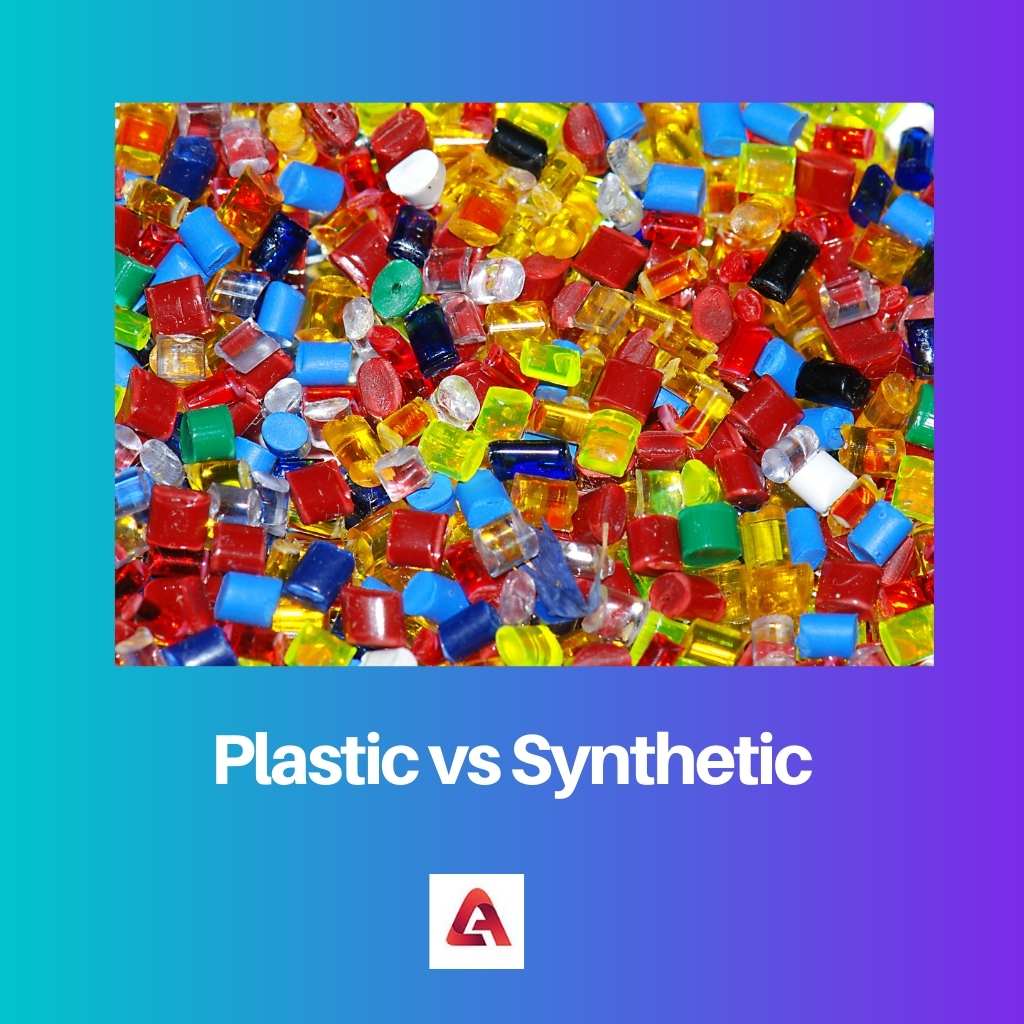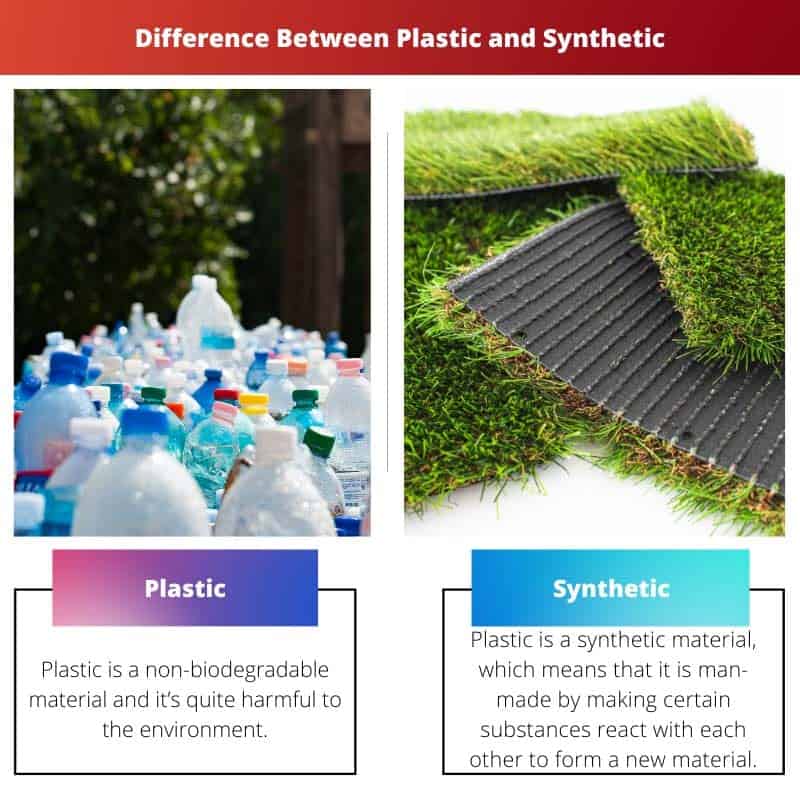Plastic is a non-biodegradable material, and it’s quite harmful to the environment. Even still plastic is used in the packaging of almost every product on earth.
Plastic is also what we call a synthetic material, which means that it is man-made by making certain substances react with each other to form a new material.
Key Takeaways
- Plastic is a broad category of materials made from polymers, which can be molded or shaped when heated and solidify when cooled. At the same time, synthetic refers to any material artificially created or not naturally occurring.
- Not all synthetic materials are plastics, as synthetic can also apply to materials like synthetic fibers, rubber, and various chemicals.
- Plastics are used in various applications, including packaging, automotive components, and consumer products, while synthetic materials can have diverse uses depending on their specific properties and characteristics.
Plastic vs Synthetic
Plastic is a type of material which is made using synthetic polymers. There is no elasticity in plastic. Plastic is a lightweight material. Synthetic material is a type of material which is used in the making of other synthetic materials. Natural polymers can also be used in the making of synthetic materials.

Plastic is a strong, malleable, durable, and non-biodegradable material that is made from refining materials like natural gas, oil, or plants in ethane and propane.
These are further treated with heat. This process is called cracking which gives birth to various types of polymers and plastic being one of them.
All materials like ceramics, polymer, nylon, rayon, vinyl, plastic, etc, are synthetic materials. What this means is that these materials do not exist independently on earth, and neither do they undergo natural reactions to form.
Instead, these are created by humans artificially by mixing naturally occurring substances under heat and pressure.
Comparison Table
| Parameters of Comparison | Plastic | Synthetic |
|---|---|---|
| Definition | Plastic is a type of synthetic material made from synthetic polymers | Synthetic refers to the type of material that gives birth to other synthetic materials |
| Nature | Made from synthetic polymer only | Can be made with natural polymers as well |
| Structure | Its made of long polymer chains | Both short and long polymer chains can be found |
| Versatility | Very versatile and malleable but isn’t hard | Depending on the type of synthetic material, versatility varies |
| Elasticity | Not elastic at all | Elasticity can be controlled |
What is Plastic?
Items made from plastic can be found all around us. Bottles, packets, and wrappers are all made from plastic. The reason plastic is so extensively used is because of its versatility.
Plastic is a polymeric material that can be shaped and moulded with the help of a combination of heat and pressure.
Plastic is a tough material. It doesn’t mean it’s hard, but rather durable, despite its low density, transparency, and lightweight.
Furthermore, the composition of plastic can be altered to form various other derived materials, such as polyethene terephthalate, which is what is used to make plastic bottles.
However, plastic is also non-biodegradable. This means that it is incapable of decomposing on its own and is buried in soil and earth. This means that even after several hundred years, plastic will remain intact.
The 7 common types of plastics and some examples:
- Polyethylene Terephthalate (PET or PETE): Bottles, jars, polyester rope
- High-density Polyethylene (HDPE): Toys, milk cartons, buckets
- Polyvinyl chloride (PVC or Vinyl): Oxygen masks, credit cards, plumbing pipes
- Low-density Polyethylene (LDPE): Bubble wrap, cups, wrappers
- Polypropylene (PP): Disposable diapers, straws, containers for hot food
- Polystyrene (PS or Styrofoam): Cutlery, shipping and product packaging, egg cartons
- Other: this refers to any other plastic.

What is Synthetic?
Synthetic materials are not natural materials that are found independently. Synthetic materials can be defined as man-made materials that are created by purposely mixing various substances together and creating new materials.
These new materials obtained are called synthetic materials.
Materials like composites, plastic, ceramics, polymers, artificial foods, and synthetic fibres are all examples of synthetic materials. All of these materials are made with their unique, desirable properties in mind to achieve a certain state.
While some synthetic materials are hard, like artificial foods, synthetic fibres are more flexible. This allows them to be used in clothes and other flexible objects.
Some synthetic fabrics/fibres:
- Spandex: Also called Lycra or elastane, which is a polyester-polyurethane co-polymer. It is used in making elastic clothing like sportswear, swimwear, etc.
- Nylon: It is made of polyamide and is lightweight, stretchable, and easy to wash. This makes it suitable for underwear, sportswear, and swimwear.
- Acetate: It is derived from cellulose, and it is used to make special occasion garments due to its luxurious appearance, resistance to shrinkage and wrinkling.
- Any material with unique properties that are not available naturally, and are obtained by mixing substances, is a synthetic material, including plastic.

Main Differences Between Plastic and Synthetic
- Plastic cannot be used in clothes because it is not flexible enough to be integrated within them. For this, other synthetic materials, such as acrylic fibres, microfibers, polyester, etc., are used, which are known as synthetic fabrics.
- Plastic isn’t stretchable like synthetic fibres made into spandex materials. This keeps the uses of plastic to a limited field, unlike other synthetic materials that have no such boundary.
- Plastic can only ever be made from synthetic polymers. However, different synthetic materials may or may not contain natural polymers as well, such as polyethene, polyester, nylon, Teflon, etc.
- The strength of plastic lies within a given range beyond which it will break. A different synthetic material, however, can be altered to be stronger or weaker, as required.
- All plastic products are synthetic materials, but all synthetic materials are not plastic. Also, the number of types of synthetic materials far exceeds the number of types of plastic.




